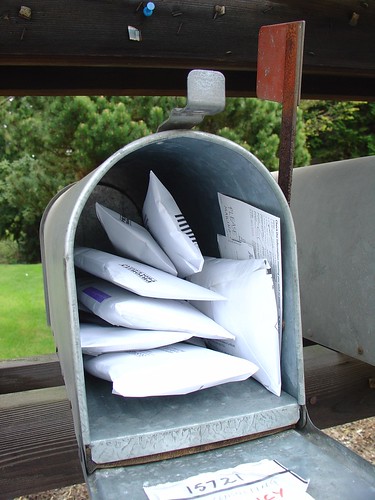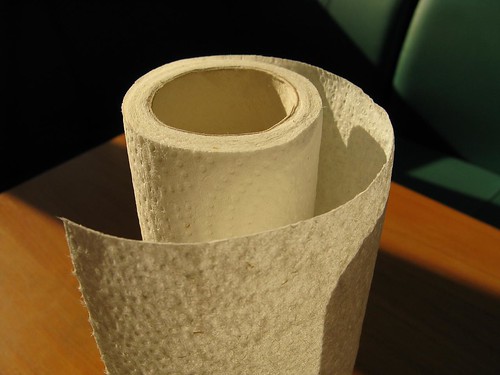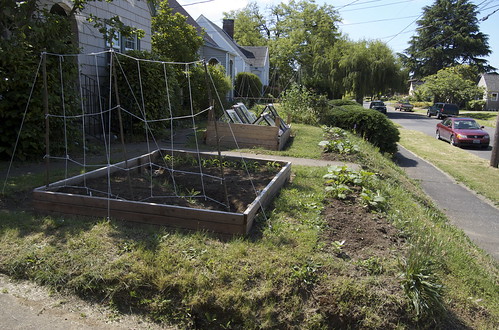I found this story in the New York Times and thought you all might enjoy it. Whether seasoned gentleman farmer or suburban homesteading newbie, I think anyone would enjoy learning something new that could benefit their homestead, I know I would. And, what a great way to meet like-minded people.
Read the story here…
Three Easy Steps To Get You Started – Homesteading In Suburbia
Part Two of a Three Part Series
STEP TWO – Doing The Research
Now that you’ve discussed your homesteading ideas with the family and have a list of homesteading activities you’d like to pursue it’s time to see how much of it is possible.
Using the answers to the questions in STEP ONE find out what is allowed by your city or Homeowners Association (HOA), if you have an association. This becomes especially important if raising livestock or installing solar or wind energy is on your list of homesteading activities. Even asking about installing a clothes line can be important because some cities prohibit the use of clothes lines for aesthetic reasons. But there are ways around that, which will be discussed later.
Remember though, not all questions will need an answer by the city or HOA, but they will need to be answered.
To make the process easier, list all the questions that need an answer. Then decide if the question needs an answer by the city or HOA or some other resource. Then call each one. Don’t just rely on one entity for your final answer because HOA regulations may differ from what the city allows. And, in some cases the HOA rules may override the city.
Questions like “Are chickens allowed in my area? Or, “How far does a compost pile need to be from my property line?” are common.
Sometimes it’s easier to visit City Hall in person. That way you can talk with the proper department or multiple departments without having calls transferred and possibly disconnected. Also, if there is a fee for printed materials or a “no mail” policy for printed materials you will already be there to handle it. The goal is to get the information you need as quickly as possible so you can start your homesteading projects.
The categories below follow the question categories in STEP ONE and list some simple questions you may need answers to. Read the rest of the story »
Trade in those rolls of paper towels and those packages of paper napkins for washable, re-useable cloth, and put the savings to work on your homestead. For the cost of a roll of paper towels or a package of paper napkins, you can buy good quality, long-lasting cloth towels and napkins that will last for years – saving you hundreds of dollars each year.
To save even more money replace all paper goods (plates, cups, eating utensils, table clothes, etc.) with washable and re-useable ones and watch your savings grow even more.
Three Easy Steps To Get You Started – Homesteading In Suburbia
Part One of a Three Part Series
Starting a suburban homestead can be a daunting task, not to mention gleaning through the mounds of information and trying to scale it down to meet the needs of your suburban homestead. With this in mind, Suburban Homesteading – One, Two, Three will lay out the basic steps for turning your suburban home into a productive homestead.
During the homesteading era of the 1800’s, a family’s primary concerns were to provide shelter, warmth, food and water. But for the modern day suburban homesteader, these are either already provided through the home (i.e. heat and water) or easily accessible as in the case of food from a grocery or big-box store. So, homesteading becomes a choice rather than a necessity. Even though you have time to think about what you want to do as a suburban homesteader, there are still practical steps each family should take. And the first step to take is to PLAN.
STEP ONE – Having the Family Discussion
If you’ve been thinking about turning your humble suburban lot into a thriving, productive “mini-farm,” discuss it with your family first…kids included. It’s difficult to homestead alone, and without the family’s “buy-in,” it can be an uphill struggle.
Talk about the kind of homestead you want to have and how self-sufficient you want to become.
The most important step in a successful homestead that doesn’t overwhelm you is “THE PLAN”. Since this is the beginning stage of the plan, dream big and list everything you want to do, be and have. Don’t worry about having enough space or buying the right supplies, there are plenty of people who grow food on apartment balconies or on condo patios.
Reality will set in soon enough – forcing you to scale down your plans and be a bit more realistic. But, for now, the sky’s the limit.
To help get you talking about the possibilities a sampling of questions you and your family will want talk about is below. As you go through this process, more questions may come to mind. Include any of your own questions along with the answers to the list that is provided. This is by no means all the questions that should be asked. They’re provided just to get you thinking.
The answers to some of these questions will depend on the amount of time and effort you want to dedicate, and can dedicate to your homesteading venture.
Be sure to write down your answers so you’ll have them for future steps in the process. Read the rest of the story »
Water conservation is a top priority on any homestead.
One way to help save all you can is to keep a plastic pitcher near the sink. Use it to collect ice cubes, leftover water in glasses, water from cooking pasta, potatoes, hard boiled eggs, etc. You’ll be amazed at how much accumulates throughout the day.
Once the pitcher is full the water can be used for potted plants or in the garden – saving what is needed from the tap.
Living a homesteading life is about living simply and carefully, managing the resources your family has. And that includes your cash.
In these tough times everyone is watching how they spend their money and what they spend it on. But, have you ever challenged yourself to see if you can keep the money that’s in your wallet – in your wallet?
It might be interesting to see how long you can make a $20 bill last.
So, here’s the challenge – during the course of a week or a day, remove all the credit cards and cash from your wallet, except for one $20 bill. The limited amount of cash will encourage you to think about which of your usual expenses are essential and which ones are just nice to have. Think about some of your usual non-essential purchases, such as lunch, a newspaper, a coffee or a car wash.
Through the course of the challenge, think about the non-essential purchases you make and identify ways to supplement them, so you don’t feel you are depriving yourself. If you normally buy lunch, pack a lunch from home. You’ll be surprised how much money this will save you.
Do you buy a newspaper or a magazine throughout the day? Switch to on-line news sources or bring a book to read instead. Better yet, bring a book about a homesteading skill you’d like improve on or learn.
If an afternoon coffee is your crutch, bring your own supplies from home and make your java at work. Remember – you can enjoy your lunch or coffee along with the book, outside in the fresh air where you can clear your head and shake off the stresses of the day.
If you’re use to having your car washed every week, try using an inexpensive “Wash Only” car wash. You know – the kind where you stay in your car while it’s being washed. The inside cleaning can be done at home for free. Or, put yourself on a once a month car wash schedule then move towards a “when-ever-it-needs-it” plan.
The goal of the challenge is to see how thrifty you can be, how far you can stretch your money, identify areas of non-essential spending and most important of all SAVE YOUR CASH.
Build A Suburban Homestead Library – Livestock & Small Farm Magazines
There are so many great websites with mounds of homesteading information on the internet, but there are also some awesome magazines as well. Some are commonly found on newsstands, in bookstores or at local public libraries while others take some digging to find.
Whether you have a country or suburban homestead, the magazines below cover all areas of homesteading and would be wonderful additions to any home library.
 1. Countryside & Small Stock Journal – is brimming with hands-on information about building, energy, recycling, livestock, gardening and a host of other homestead related topics. This well established magazine is completely reader written with many small articles and tidbits. You won’t find articles written by researchers with no application experience or about university tests. The authors have real hands-on experience in what they’re writing about.
1. Countryside & Small Stock Journal – is brimming with hands-on information about building, energy, recycling, livestock, gardening and a host of other homestead related topics. This well established magazine is completely reader written with many small articles and tidbits. You won’t find articles written by researchers with no application experience or about university tests. The authors have real hands-on experience in what they’re writing about.
2. Hobby Farms® – although the magazine is geared toward rural enthusiasts, hobby farmers, small production farmers and those passionate about the country addresses all aspects of homestead life. Hobby Farms highlights “rural living for pleasure and profit.”
3. Hobby Farm Home® – is the home magazine for those truly living the country life. But, like Hobby Farms, this magazine is also well suited for those striving for a more self-sufficient life because it highlights farmhouse activities such as cooking, crafting, collecting, pet care and home arts and skills.
4. BackHome magazine – is a quarterly magazine that delivers useful do-it-yourself information on sustainable, self-reliant living for those interested in taking control of their own lives. The bi-monthly issues are packed with clear, practical information on mortgage-free building, solar and renewable energy, chemical-free gardening, wholesome cooking, home business, home schooling, small livestock, vehicle and workshop projects, and family activities
5. Backyard Poultry & Dairy Goat Journal – is part of the Countryside family of magazines and focus on individual species of animals. Each issue provides timely articles and current news of interest to poultry and dairy goat owners as well as breed selection, housing, management, health and nutrition, rare and historic breeds and other topics that promote better small-scale production. Read the rest of the story »
If you’ve decided to take control of your life in these uncertain economic times, you’re not alone.
Thousands of families are taking control of their lives by turning their “home” into a “homestead”. And, in doing so, they’ve found a level of personal security in being less vulnerable.
Economic survivalists take root
When the economy started to squeeze the Wojtowicz family, they gave up vacation cruises, restaurant meals, new clothes and high-tech toys to become 21st-century homesteaders.
Now Patrick Wojtowicz, 36, his wife Melissa, 37, and daughter Gabrielle, 15, raise pigs and chickens for food on 40 acres near Alma, Mich. They’re planning a garden and installing a wood furnace. They disconnected the satellite TV and radio, ditched their dishwasher and a big truck and started buying clothes at resale shops.
“As long as we can keep decreasing our bills, we can keep making less money,” Patrick says. “We’re not saying this is right for everybody, but it’s right for us.”
Hard times are creating economic survivalists such as the Wojtowicz family who are paring expenses by becoming more self-sufficient.
Read more about one family’s venture into a more self-sufficient lifestyle.

Are you bombarded every day by the never ending pile of junk mail that arrives in your mailbox? Is it a challenge to manage the stacks that accumulate all over the house?
Well, you’re not alone. The average consumer receives 41 pounds of junk mail each year, according to 41Pounds.net, an organization that removes your name and address from dozens of organizations for a small fee.
But, we like the companies that allow you to opt out for FREE!
Go to www.optoutprescreen.com to have your name removed from the mailing lists used by the three major credit bureaus. It takes just a few minutes, and should reduce the number of credit card and insurance offers you receive.
To cancel catalogs you no longer wish to receive visit www.catalogchoice.org.
In the meantime don’t forget to destroy the mailing label and recycle the unwanted junk mail!





 Cities all over the world will be celebrating Earth Day 2009 throughout the month of April. Although each city celebrates in their own and unique way, most focus a great deal on gardening, self-sufficient living, energy efficiency, composting and the like.
Cities all over the world will be celebrating Earth Day 2009 throughout the month of April. Although each city celebrates in their own and unique way, most focus a great deal on gardening, self-sufficient living, energy efficiency, composting and the like.
Recent comments
Aenean nonummy hendrerit mauris. Phasellus porta.